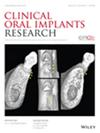Odanacatib Coating Supports Osseointegration of Implants: A Preclinical Study.
IF 5.3
1区 医学
Q1 DENTISTRY, ORAL SURGERY & MEDICINE
引用次数: 0
Abstract
INTRODUCTION Odanacatib (ODN), a cathepsin K inhibitor, is a drug that reduces bone resorption while preserving bone formation. ODN was initially developed for the treatment of postmenopausal osteoporosis, but further development as a systemic medication has been discontinued. Here, we propose ODN as a topical treatment, the coating of dental implants, to achieve an anabolic shift of early osseointegration. MATERIAL AND METHODS To this aim, we have coated double acid etching titanium implants (SLA) with and without ODN dispersed in a simulated body fluid (SBF). The implants were inserted into the tibia of 72 male Wistar rats and osseointegration was studied on Days 15 and 40. Biomechanical testing, micro-computed microtomography, and histomorphometric analyses were performed. RESULTS Biomechanical testing reveals that after 15 days of healing, removal torque increased from 2.5 Ncm (1.5-4.4) to 3.9 Ncm (1.7-7.6) when comparing SBF alone with SBF containing ODN, respectively (p = 0.017). Consistently, micro-computed microtomography indicated that local bone volume increased from 24.4% (13.86-32.45) to 32.8% (19.7-39.4), respectively (p = 0.003). The same was true for presumed bone-to-implant contact, which was 34.38% (27.0-50.0) and 43.33% (31.6-54.2), respectively (p = 0.035). Histomorphometric analyses confirmed that the new bone area per total area increased from 34.78% (18.9-43.7) to 41.10% (23.5-54.0), respectively (p = 0.102). This trend proceeds after 40 days of osseointegration. DISCUSSION These findings suggest that topical delivery of a cathepsin K inhibitor can support the early osseointegration phase in an ectopic rodent implantation model.Odanacatib涂层支持种植体骨整合:临床前研究。
odanacatib (ODN)是一种组织蛋白酶K抑制剂,是一种减少骨吸收同时保持骨形成的药物。ODN最初用于治疗绝经后骨质疏松症,但作为全身药物的进一步发展已经停止。在这里,我们提出ODN作为局部治疗,牙种植体涂层,以实现早期骨整合的合成代谢转变。为了达到这个目的,我们在模拟体液(SBF)中涂覆有ODN和没有ODN的双酸蚀刻钛植入物(SLA)。将植入物置入72只雄性Wistar大鼠胫骨,在第15天和第40天观察其骨整合情况。进行了生物力学测试、显微计算机断层扫描和组织形态学分析。结果生物力学测试显示,愈合15 d后,与单纯SBF和含ODN的SBF相比,去除扭矩分别从2.5 Ncm(1.5-4.4)增加到3.9 Ncm (1.7-7.6) (p = 0.017)。显微计算机断层扫描显示,局部骨体积从24.4%(13.86 ~ 32.45)增加到32.8%(19.7 ~ 39.4),差异有统计学意义(p = 0.003)。假定的骨与种植体接触也是如此,分别为34.38%(27.0-50.0)和43.33% (31.6-54.2)(p = 0.035)。组织形态学分析证实,新骨面积占总面积的比例分别从34.78%(18.9-43.7)增加到41.10% (23.5-54.0)(p = 0.102)。这种趋势在骨融合40天后继续。这些研究结果表明,局部递送组织蛋白酶K抑制剂可以支持异位植入模型的早期骨整合阶段。
本文章由计算机程序翻译,如有差异,请以英文原文为准。
求助全文
约1分钟内获得全文
求助全文
来源期刊

Clinical Oral Implants Research
医学-工程:生物医学
CiteScore
7.70
自引率
11.60%
发文量
149
审稿时长
3 months
期刊介绍:
Clinical Oral Implants Research conveys scientific progress in the field of implant dentistry and its related areas to clinicians, teachers and researchers concerned with the application of this information for the benefit of patients in need of oral implants. The journal addresses itself to clinicians, general practitioners, periodontists, oral and maxillofacial surgeons and prosthodontists, as well as to teachers, academicians and scholars involved in the education of professionals and in the scientific promotion of the field of implant dentistry.
 求助内容:
求助内容: 应助结果提醒方式:
应助结果提醒方式:


